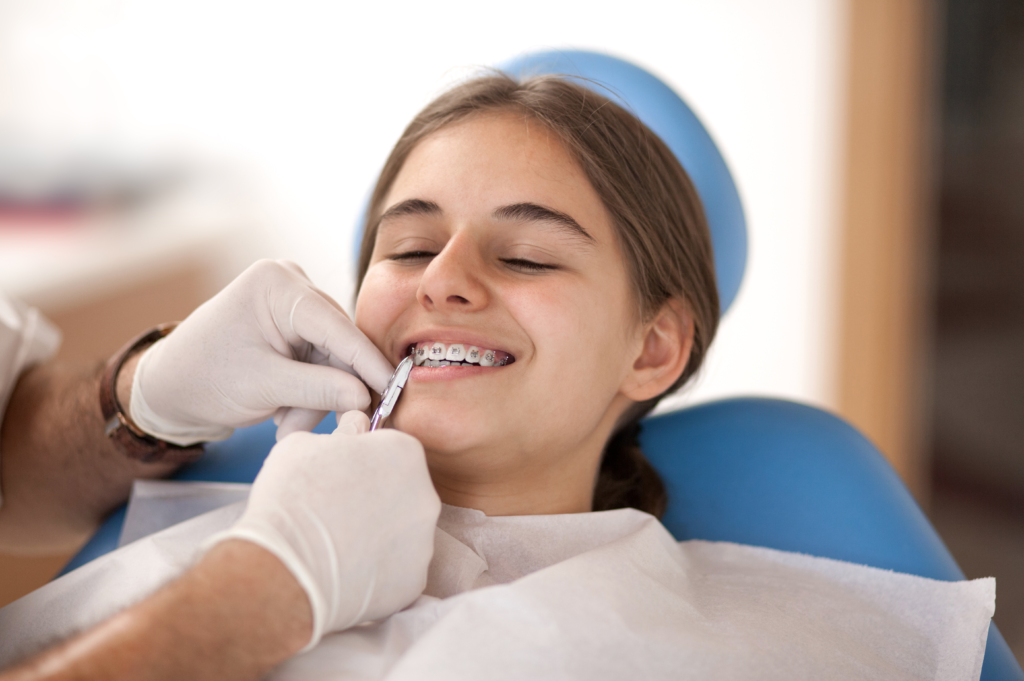How Braces Work on Gap Teeth
How Braces Work on Gap Teeth: A Complete Guide

Gap teeth, medically known as diastema, are a common dental condition where there is noticeable space between two teeth, typically the upper front teeth. Many people with gap teeth feel self-conscious about their smile, but the good news is that modern orthodontic solutions like braces can effectively close these gaps and improve both aesthetics and function.
In this blog, we will explore how braces work to close gaps in teeth and what you can expect during the treatment process.
Why Do Gaps in Teeth Occur?
There are several reasons why gaps may develop between teeth:
- Jaw Size: A mismatch between the size of the jaw and the size of the teeth can cause gaps.
- Tooth Size: Small teeth relative to the jaw can lead to spaces.
- Missing Teeth: Missing teeth can create gaps that make other teeth shift out of place.
- Habits: Thumb-sucking or tongue thrusting can push teeth apart, causing gaps.
- Genetics: Gaps may also be hereditary, meaning they run in families.
Regardless of the cause, braces are a time-tested and effective way to close gaps in teeth.
How Braces Close Gaps
Braces use a combination of brackets, wires, and elastic bands to apply constant, gentle pressure on the teeth over time. Here’s how braces specifically address gaps in teeth:
Initial Placement of Braces: The orthodontist will bond metal or ceramic brackets to the teeth and connect them with a flexible wire. This wire exerts gentle pressure, gradually moving teeth closer together.
Force and Alignment: As the wire tightens, it pulls the teeth toward each other, closing the gaps. This movement is slow and precise, ensuring that teeth shift into their correct positions without causing damage to the surrounding bone or gums.
Periodic Adjustments: Every few weeks, the orthodontist will adjust the braces, tightening the wires or changing elastics to keep up the pressure needed for further movement.
Use of Power Chains: For more significant gaps, orthodontists may use a power chain, which is a string of connected elastics that stretches across multiple brackets. The power chain pulls teeth together more quickly than individual elastic bands, effectively closing gaps.
Retainers: Once the gaps have closed, a retainer is used to maintain the new position of the teeth and prevent them from shifting back.
Types of Braces for Gap Teeth
Metal Braces: Traditional metal braces are highly effective for closing gaps. They are durable and provide strong pressure to move teeth efficiently.
Ceramic Braces: These braces work similarly to metal braces but are less noticeable because the brackets are tooth-colored. They are a popular choice for adults concerned about aesthetics.
Invisalign: If you’re looking for a more discreet option, clear aligners like Invisalign can also close gaps. However, they may not be suitable for all cases, especially severe gaps.
How Long Does It Take to Close Gaps with Braces?
The time it takes to close gaps depends on several factors:
- Size of the Gap: Smaller gaps may close within a few months, while larger gaps can take up to two years.
- Type of Braces: Traditional metal braces tend to work faster than other options like ceramic braces or Invisalign.
- Patient Compliance: Regular visits to the orthodontist and following all instructions, such as wearing retainers, are crucial for speeding up the process.
On average, most patients wear braces for 12 to 24 months to close gaps and correct other alignment issues.
Benefits of Closing Gap Teeth with Braces
Improved Appearance: One of the main reasons people opt for braces is to achieve a more even, attractive smile.
Better Oral Health: Gaps between teeth can trap food and bacteria, leading to plaque buildup and an increased risk of cavities or gum disease. Closing gaps improves oral hygiene.
Improved Speech: Some people with large gaps may have difficulty pronouncing certain sounds. Braces can help improve speech by aligning the teeth properly.
Boost in Confidence: A more aligned smile often leads to increased confidence and self-esteem.
Braces are an effective solution for closing gaps in teeth, whether they are caused by genetics, habits, or missing teeth. While the treatment may take time, the results are long-lasting and can lead to a healthier, more confident smile. If you’re considering braces to correct gap teeth, consult with a trusted orthodontist, such as those at Dhariya’s Clinic, to discuss the best treatment plan for your specific needs.
Let us help you achieve a gap-free, beautiful smile at Dhariya’s Clinic!
